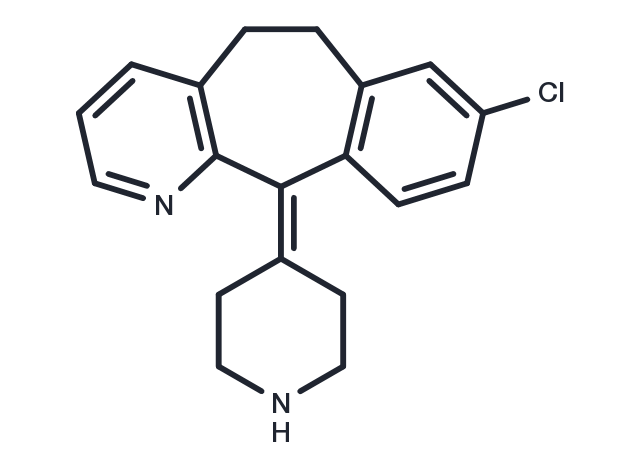Powder: -20°C for 3 years | In solvent: -80°C for 1 year
Desloratadine (Sch34117) 是非镇静H1抗组胺药 Loratadine 的主要口服代谢物,可减少对支气管平滑肌、毛细血管和胃肠道平滑肌中 H1 受体的典型组胺能作用,包括血管舒张、支气管收缩、血管通透性增加、疼痛、瘙痒和胃肠道平滑肌的痉挛性收缩。它是一种选择性H1受体拮抗剂,具有抗过敏和抗炎活性。

| 规格 | 价格/CNY | 货期 | 数量 | |
|---|---|---|---|---|
| 50 mg | ¥ 415 | 现货 | ||
| 100 mg | ¥ 614 | 现货 | ||
| 500 mg | ¥ 2,429 | 现货 | ||
| 1 g | ¥ 3,862 | 现货 | ||
| 产品描述 | Desloratadine (Sch34117) is a long-acting piperidine derivate with selective H1 antihistaminergic and non-sedating properties. Desloratadine diminishes the typical histaminergic effects on H1-receptors in bronchial smooth muscle, capillaries and gastrointestinal smooth muscle, including vasodilation, bronchoconstriction, increased vascular permeability, pain, itching and spasmodic contractions of gastrointestinal smooth muscle. Desloratadine is used to provide symptomatic relieve of allergic symptoms. |
| 靶点活性 | H1 receptor:51 nM |
| 体外活性 | Desloratadine抑制小鼠体内组胺诱导的足肿胀,ED50为0.15 mg/kg.去氯雷他定(1 mg/mL,3 mg/mL和10 mg/mL)在体内诱导豚鼠的剂量依赖性和持久散瞳.Desloratadine抑制豚鼠体内组胺侵袭上呼吸道引起的血管通透性增加,ED50为0.9 μg.5 mg/kg Desloratadine通过破坏清醒小鼠中的血脑屏障而引起抑制氧化震颤素诱导的震颤. |
| 体内活性 | Desloratadine是卡巴胆碱诱导的离体兔虹膜平滑肌收缩的竞争性拮抗剂,pA2为6.67。 D去氯雷他定以0.87 nM的Ki值结合人H1受体,取代氚标记的美吡拉敏。Desloratadine在竞争性结合研究中,比西替利嗪,依巴斯汀,非索非那定和氯雷他定分别有效52,57,194以及153倍。0.1 μM到10 μM Desloratadine也显示抑制血小板活化因子诱导的嗜酸性粒细胞趋化性和TNF-α诱导的嗜酸性粒细胞在患有变应性鼻炎或变应性哮喘的患者中的嗜酸性粒细胞粘附。0.1 μM-10 μM Desloratadine剂量依赖性来自人嗜碱性粒细胞的IL-3和PMA活化的嗜碱性粒细胞的IL-13分泌。10 μM Desloratadine在培养的嗜碱粒细胞中,预处理导致培养的嗜碱性粒细胞中抗-IgE活化积累的IL-4信息减少约80%。[3H]Desloratadine以1.1 nM的Kd结合CHO细胞中表达的人组胺H1受体。100 nM到10 μM Desloratadine抑制IgE介导的和非IgE介导的人嗜碱粒细胞中细胞因子IL-4 和IL-13的产生。300 nM到100 μM Desloratadine抑制IgE介导的和非IgE介导的组胺从人周边血液嗜碱性粒细胞的释放。 |
| 别名 | Sch34117, 地氯雷他定, NSC 675447 |
| 分子量 | 310.82 |
| 分子式 | C19H19ClN2 |
| CAS No. | 100643-71-8 |
Powder: -20°C for 3 years | In solvent: -80°C for 1 year
Ethanol: 31.1 mg/mL (100 mM)
DMSO: 6.2 mg/mL (20 mM)
| 可选溶剂 | 浓度 体积 质量 | 1 mg | 5 mg | 10 mg | 25 mg |
| Ethanol / DMSO | 1 mM | 3.2173 mL | 16.0865 mL | 32.173 mL | 80.4324 mL |
| 5 mM | 0.6435 mL | 3.2173 mL | 6.4346 mL | 16.0865 mL | |
| 10 mM | 0.3217 mL | 1.6086 mL | 3.2173 mL | 8.0432 mL | |
| 20 mM | 0.1609 mL | 0.8043 mL | 1.6086 mL | 4.0216 mL | |
| Ethanol | 50 mM | 0.0643 mL | 0.3217 mL | 0.6435 mL | 1.6086 mL |
| 100 mM | 0.0322 mL | 0.1609 mL | 0.3217 mL | 0.8043 mL |
对于不同动物的给药剂量换算,您也可以参考 更多...
请在以下方框中输入您的动物实验信息后点击计算,可以得到母液配置方法和体内配方的制备方法: 比如您的给药剂量是10 mg/kg,每只动物体重20 g,给药体积100 μL,一共给药动物10 只,您使用的配方为5% DMSO+30% PEG300+5% Tween 80+60% ddH2O。那么您的工作液浓度为2 mg/mL。
母液配置方法:2 mg 药物溶于 50 μL DMSO (母液浓度为 40 mg/mL), 如您需要配置的浓度超过该产品的溶解度,请先与我们联系。
体内配方的制备方法:取 50 μL DMSO 主液,加入 300 μL PEG300, 混匀澄清,再加 50 μL Tween 80,混匀澄清,再加 600 μL ddH2O, 混匀澄清。
您可能有的问题的答案可以在抑制剂处理说明中找到,包括如何准备库存溶液,如何存储产品,以及基于细胞的分析和动物实验需要特别注意的问题。
Desloratadine 100643-71-8 GPCR/G Protein Immunology/Inflammation Metabolism Neuroscience Endogenous Metabolite Histamine Receptor NSC675447 Sch 34117 inhibit Sch34117 地氯雷他定 Sch-34117 NSC 675447 Inhibitor NSC-675447 inhibitor
